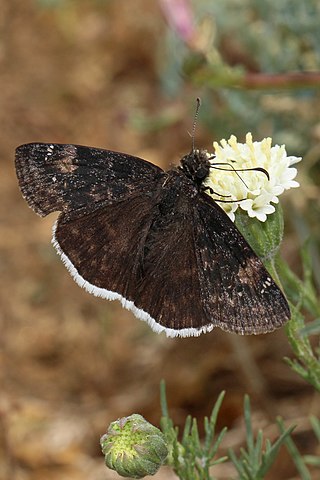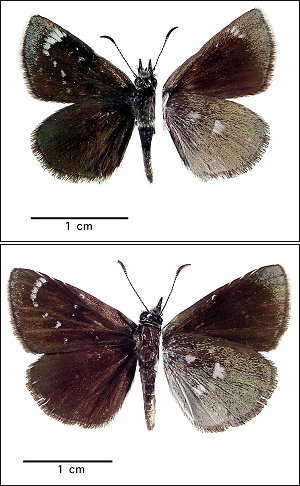
Pholisora is a genus of skippers in the family Hesperiidae.

Amblyscirtes vialis is a butterfly of the family Hesperiidae. It is found from British Columbia east across southern Canada to Maine and Nova Scotia, south to central California, northern New Mexico, Texas, the Gulf states and northern Florida.

Lerodea eufala, the Eufala skipper or rice leaffolder, is a species of butterfly in the family Hesperiidae. It is found from the coast of Georgia, south through Florida and west across the southern United States to southern California, south through Mexico and Central America to Patagonia. In the summer, it expands its range north to central California, North Dakota, southern Wisconsin, northern Michigan and Washington, D.C.

Anthanassa frisia, the Cuban crescentspot, Cuban checkerspot or Cuban crescent, is a butterfly of the family Nymphalidae. Subspecies tulcis is known by the common names pale-banded crescent or Tulcis crescent; it is treated as a species by some authors.

Erynnis funeralis, commonly known as the funereal duskywing, is a species of butterfly of the family Hesperiidae. It is found from southern United States, south to Argentina and Chile. Strays can be found north up to northern Illinois, north-eastern Nebraska, central Colorado, southern Nevada and central California.

Calpodes ethlius, the Brazilian skipper, larger canna leafroller or canna skipper, is a butterfly of the family Hesperiidae. It is found in the United States from southern Florida and southern Texas, south through the West Indies, Mexico, and Central America to Argentina. Strays and temporary colonies can be found north to southern Nevada, northern Texas, Illinois and Massachusetts.

Wallengrenia egeremet, the northern broken dash , is a butterfly of the family Hesperiidae. It is found in North America from southern Maine and southern Ontario, west across the Great Lakes states to southeastern North Dakota, south to central Florida, the Gulf Coast and south-eastern Texas.

Wallengrenia otho, the southern broken dash or broken dash skipper, is a butterfly of the family Hesperiidae. It was originally described by Smith in 1797. It is found from eastern Texas and the southeastern United States, south through the West Indies and Central America to Argentina. Strays can be found as far north as central Missouri, northern Kentucky and Delaware.

Cecropterus dorantes, the lilac-banded longtail or Dorantes longtail, is a species of butterfly in the family Hesperiidae. It is found from Argentina, north through Central America, Mexico, and the West Indies to southern Texas and peninsular Florida. Strays can be found as far north as northern California, southern Arizona, southern Missouri and North Carolina.

Vernia verna, the little glassywing, is a species of butterfly of the family Hesperiidae. It is found in the eastern United States and southeastern Canada, from central New England west to central Nebraska, south to northern Florida, the Gulf Coast and southern Texas.

Hesperopsis libya, the Mojave sootywing, Mohave sootywing, Great Basin sootywing or Lena sooty wing, is a butterfly of the family Hesperiidae. It is found in North America from eastern Oregon east to Montana and south to southern California, Arizona, and north-western Mexico including Baja California. Its habitats include alkalai flats, sagebrush desert, desert hills, shale barrens, watercourses, and ravines.

Anthanassa texana, the Texan crescentspot, is a species of butterfly in the family Nymphalidae. It is found from Guatemala north through Mexico to southern California, east across the southern United States to northern Florida, Georgia and South Carolina. Strays may be found up to Arkansas, Missouri, Illinois, South Dakota, and central Nevada. The habitat consists of deserts, dry gulches, open areas, streamsides, road edges, and city parks.
Sootywing is the common name of several species and subspecies of butterfly, including:













